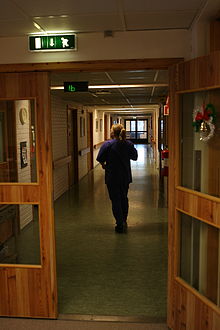Care of Elderly care, or simply eldercare (also known in parts of the English speaking world as aged care), is the fulfillment of the special needs and requirements that are unique to senior citizens. This broad term encompasses such services as assisted living, adult day care, long term care, nursing homes (often referred to as residential care), hospice care, and home care. Because of the wide variety of elderly care found nationally, as well as differentiating cultural perspectives on elderly citizens, it cannot be limited to any one practice. For example, many countries in Asia use government-established elderly care quite infrequently, preferring the traditional methods of being cared for by younger generations of family members.
Elderly care emphasizes the social and personal requirements of senior citizens who need some assistance with daily activities and health care, but who desire to age with dignity. It is an important distinction, in that the design of housing, services, activities, employee training and such should be truly customer-centered. It is also noteworthy that a large amount of global elderly care falls under the unpaid market sector.[1]
Cultural and geographic differences[edit]
The form of care provided for older adults varies greatly among countries and is changing rapidly.[2] Even within the same country, regional differences exist with respect to the care for older adults.[3] However, it has been observed globally that older people consume the most health expenditures out of any other age group.[4] An observation that shows comprehensive eldercare may be very similar. One must also account for an increasingly large proportion of older people worldwide, especially in developing nations, as continued pressure is put on limiting fertility and decreasing family size.[5]
Traditionally, care for older adults has been the responsibility of family members and was provided within the extended family home.[6] Increasingly in modern societies, care is now being provided by state or charitable institutions.[6] The reasons for this change include decreasing family size, greater life expectancy, the geographical dispersion of families.[6] Although these changes have affected European and North American countries first, they are now increasingly affecting Asian countries as well.[7]
In most western countries, care facilities for older adults are residential family care homes, freestanding assisted living facilities, nursing homes, and continuing care retirement communities (CCRCs).[8] A family care home is a residential home with support and supervisory personnel by an agency, organization, or individual that provides room and board, personal care and habilitation services in a family environment for at least two and no more than six persons.[9]
Gender discrepancies in caregivers[edit]
According to Family Caregiver Alliance, the majority of family caregivers are women:[10]
"Many studies have looked at the role of women as family caregivers. Although not all have addressed gender issues and caregiving specifically, the results are still generalizable [sic] to
- Estimates of the age of family or informal caregivers who are women range from 59% to 75%.
- The average caregiver is age 46, female, married and worked outside the home earning an annual income of $35,000.
- Although men also provide assistance, female caregivers may spend as much as 50% more time providing care than male caregivers."[10]
source - https://en.wikipedia.org/wiki/Elderly_car




No comments:
Post a Comment